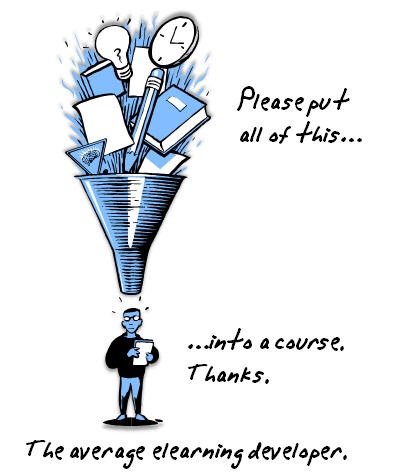Lovely post as usual. The tips you share are amazing! Thanks for sharing.
If you listen to the pundits and some elearning experts, you’d think that only those expensive elearning courses custom built in Flash have any value. While these people pay lip service to rapid elearning, they usually relegate it to low-level elearning. This is really code for ineffective or boring, “click and read” elearning. Some of them even look at rapid elearning with disdain. And believe it or not, they think that many of you aren’t capable of building effective elearning courses.

As my daughter would say, “That’s stinkin’ thinkin’!” If you’re a regular reader of this blog, then you know that’s flat out wrong. Of course, there are some poorly designed rapid elearning courses which appear to give credence to that argument. But it won’t take much of a search to find just as many examples of poorly designed elearning built the non-rapid way. In fact, poorly designed elearning was an art form years before the first rapid elearning course came to market.
Let me tell you why rapid elearning’s not only cool but here to stay. In fact, it’s the future.
It’s easy to lose sight of the fact that most people who build elearning aren’t the high profile vendors talking about $100,000 courses. At the recent ASTD conference in San Diego, I got to meet many of you and hear some of your stories. Talking to you and getting your emails helps me keep my perspective real and focused on what’s practical for most people. Here are three examples from conversations I had with some rapid elearning developers. I think they represent many of the uses of rapid elearning software and demonstrate the value the tools bring to their organizations.
Subject Matter Experts Are Empowered
One training manager told me that they used to send their staff out to learn Flash programming. However, they found that it just wasn’t effective because of Flash’s learning curve and their production needs. So, they opted for a rapid elearning strategy instead.
He told me that it’s been highly successful. In fact, they now train their subject matter experts (SME) to use the tools. The SME are highly skilled and work in a very fast-paced environment. Now that they know how to use the rapid elearning software, it’s routine for them to quickly build or modify their elearning courses with up-to-date information and have it ready for the following shifts. By putting it online, they also are able to quickly develop and maintain their standard operating procedures.
What’s really cool is that these aren’t just bullet point slide shows converted to Flash. Instead, they’re media rich elearning with video and audio that trains people on very complex machinery and procedures.
Blended E-learning That Meets Real Needs
A different manager said they combined rapid elearning modules with their facilitated sessions. They use elearning to expedite the information sharing and some self-paced case studies. Then, they have breakout sessions where the learners are able to discuss what they learned and work through case studies.
Using rapid elearning proves effective on a number of levels. First, they’re able to produce them in-house and save about $15,000 per course (as compared to when a vendor was building them). Because they control the production process, they can make changes on the fly. In fact, they can make same day changes. They’ll get feedback from class participants and during a break make changes to better reflect the needs of the learners.

Changing the World One Course at a Time
Another person I talked to was a one-person shop who is responsible for building elearning courses for a company that serves a number of organizations in developing nations. They have a limited budget and few elearning resources. Without rapid elearning tools, he’d be slow to build and deliver courses. And in his case, there would literally be thousands of people in other countries who would not have access to the valuable information to help improve their communities.
These are three examples from the dozens of people I talked to. They’re a good reflection of how many organizations are leveraging elearning. And they really speak to the power of the rapid elearning tools and how they bring real value.
Just a few years ago you couldn’t put a video in your elearning course without having a programmer build a player and the functionality. As an instructional designer, you were always held hostage by your lack of programming resources or the complexity of attempting to add multimedia. That’s not the case today. You can easily drop in all sorts of multimedia. Now, instead of being held back by your programming limitations, the rapid elearning software opens the door to all sorts of possibilities.
In the same sense, you weren’t able to quickly make edits to a Flash authored course. Typically, you’d have to get a programmer and then put the project in a queue hoping that your project would get priority. Not so any more.
In the example above, the trainer was able to quickly modify the elearning scenarios and case studies to build courses that better reflected the learner’s needs right at the point of contact. Talk about just in time.
The last example is probably most typical of those who build rapid elearning. It’s all about making the best of limited resources. There’ll always be a place for the high profile $100,000 courses, but the reality is that those are in the minority.
The Future’s So Bright I Gotta Wear Shades
Here’s the deal. Rapid elearning is all about automating the elearning production process. Once the process is automated, it puts more capability into the hands of creative people. They don’t have to worry about programming constraints and can spend their efforts building better learning.
Today, the rapid elearning software has removed the barriers to incorporating multimedia. However, now the issue for instructional designers is adding advanced interactivity and building more engaging learning environments. For many, it still costs a lot or takes too much time to build the right type of interactivity. Well, that’s changing, too.
In the next generation elearning tools, you’ll be able to build Flash animations in what I like to call “PowerPoint comfort.” This is the first step. Soon all of the complex steps to building interactivity will be automated and for most, this will remove many of the technical barriers. You’ll eliminate the need for to have Flash programmers build even your most complex courses.
What you see in some of those $100,000 courses today, you’ll be able to build yourself without the need for advanced programming skills. Once those constraints are removed, you’ll be empowered to build the types of elearning courses you want and not be held back by expense or lack of capability. And that’s the way it should be. If I’m an instructional designer, I shouldn’t have to be a programmer to build a highly interactive elearning course.
Stay tuned. It’s going to get real exciting, real soon.
I’d love to hear your thoughts on this. Feel free to add a comment.
Events
- Everyday. Check out the weekly training webinars to learn more about Rise, Storyline, and instructional design.
Free E-Learning Resources
 |
 |
 |
|
Want to learn more? Check out these articles and free resources in the community. |
Here’s a great job board for e-learning, instructional design, and training jobs |
Participate in the weekly e-learning challenges to sharpen your skills |
 |
 |
 |
|
Get your free PowerPoint templates and free graphics & stock images. |
Lots of cool e-learning examples to check out and find inspiration. |
Getting Started? This e-learning 101 series and the free e-books will help. |
35 responses to “Here’s Why Rapid E-Learning is So Darn Cool (and Just Might Change the World)”
nice post.
The reason the vendors slander rapid eLearning is because it threatens the legitimacy of the overpriced fluff with which they make their Mercedes payments. You should see some of the garbage we’ve paid $50k+ for.
That said, we have to be careful that we don’t justify the equating of “rapid” eLearning with “crappy” eLearning. “Rapid” development to me means using something like the Articulate apps, which allow me to produce high-quality content without all the custom programming and the time (and money) that custom programming demands. And while I can do so quickly and easily, I make sure I maintain a high level of quality.
We must avoid the temptation to use Articulate stuff as a quick “garbage in, garbage out” conversion tool. For example, I won’t take a SME’s storyboard as-is and simply narrate and publish it using Articulate. That would be “rapid.” But it wouldn’t be good. In fact, I ask my SMEs to steer clear of visual design at all – just give me the content in a plain black & white PowerPoint storyboard. It doesn’t take me long to apply the visual design to the framework they’ve built, and it ensures I don’t end up with a cheesy product full of visual offenses, eye-rolling animations, Comic Sans fonts, and screen beans clip art.
Ultimately the term “rapid” – while accurate – is simply bursting with negative connotations. Perhaps we need a new adjective?
“I shouldn’t have to be a programmer to build… an e-learning course”.
Absolutely. I’m an accountant and I build training videos on Camtasia. What I know about programming would go on a postage stamp but that doesn’t stop me.
Really looking forward to hearing more about the next generation of e-learning tools and in particular the ones that help automate interactivity. Interactivity is my next big goal in building training videos.
M
I agree and disagree with this article. I think giving SMEs who have no design background a rapid authoring tool is dangerous. These are the types of courses that are usually labeled as bad eLearning courses. I know this for a true fact. I have seen so many page turners created by SMEs with bad audio, poor gifs, and outrageous graphics. These types of things hinder the learning process. And what does a SME know about learning objectives?? I think that a designer can truly become a developer within the RID model. Beign a designer, I did choose to learn Flash. Once you learn three or four basic elements, you can use them for everything. I do believe in the power of Rapid eLearning, but I don’t believe that just anybody can do it and make it effective.
Great post. I work for a large institution. We use a learning management system, we have SMEs such as myself and we have a media development team. What I’m finding is not so much a resistance to rapid e-learning but a reluctance as it bypasses our media development team. How are other people handling this type of situation?
I agree with Chris. Terms are very important. I’d like to add some clarification to the Rapid Development discussion. Rapid elearning DEVELOPMENT is different than Rapid elearning DESIGN. There’s no question that Rapid Development is achievable with the new tools. However, the only tool I know that provides Rapid Design is EXPERIENCE. You can’t buy it anywhere, but it is available everywhere. Don’t be fooled though. Some people will claim to have 10 or 15 years of experience, but what they really have is 1 year of experience 15 times.
The anticipation of Articulate’s new software seems to be growing by the day. I can’t wait to see what it will be.
I really find all your post filled with valuable information.
I am also very interested in what the next generation of elearning tools will bring.
The Director of Training shared information about a rapid e-Learning authoring tool he saw at the recent ASTD Conference. It’s called Metamorphosis by Apixel. Visit the Apixel website at http://www.apixel.com and view the video! Unreal! Also, you can download a demo copy of Metamorphosis and try it for two weeks using your own content. It’s a full operating version of the product;the only limitation is the image library is very limited and therefore, the pictures selected by the system will not be relevant to your content (but you can use them as placeholders).
I can see the application of this tool to quickly grab content and massage it into a course. It does not have the robust capabilities of other authoring tools, but I think it does have a niche.
Great post as usual, and as usual injecting us all with the excitement for the great things to come…
I would love to hear your thoughts on Rapid Development for Application Training.
Donna’s comment resonates the most for me. I don’t want to minimize the benefit of a great tool like Articulate, but more important to me is the core function of instructional design (ID). The ID process helps guide the SME through the process of creating a highly effective online course.
In higher education I have found that most SMEs are content experts in their discipline, but often have had no training in either pedagogy or instructional design. They simply design and teach as they were taught (for better or worse).
Instructional designers help bridge the gap between the core instructional content and the pedagogical issues related to creating and delivering effective online learning. Once the instructional designer and SME have worked through learning outcomes, assessment plans and instructional strategies, the SME is better prepared to imagine or create Articulate learning objects.
Does this mean you know something about new tools from Articulate?
Love to hear what you know if that’s the case!
Tom,
As usual thanks for the great post. I’d love it if you started a “rapid elearning” forum. I work for a large corporation and we’ve just converted our old, expensive e-learning courses into Articulate. We’ve been encountering many obstacles, from convincing leadership we can’t reduce design time on our project plans just because it’s “rapid”, to trying to negotiate with our very rigorous I.T. department to reduce our very long QA testing periods (which of course increases the time it takes to get this stuff out to the field.) I’m so eager to find a forum online where I can share some of my new-found knowledge and also ask questions of Rapid E-Learning Gurus. Maybe it could be here?!?!
Sorry to be cynical but I still think that the Articulate suite has some way to go to make the tools really “rapid”. The main problem is that I think you need to work on data imports. This is true for powerpoints, quizzes, and especially glossaries! Imagine if you can just give it a table for the glossary with term in the first column and definition in the second, or if the tool helps you to fully import a word doc that a SME has created with each page break being a new slide. To me, rapid means minimizing CUT and PASTE, our most loathsome jobs!!
Food for thought, if i keep voicing it, maybe someone will listen, otherwise, does anyone want to start a company? 😉
I spent 8 years in the bsepoke end of the elearning development industry and there is a need for high quality, broadcast standard elearning materials. I used to be very rude about rapid elearning (both tools, output and developers). The past 2 years have been spent at a UK university where I have gradually been sucked into advising, helping and producing rapid elearning and I’m having great fun. We are empowering SMEs to do it themselves, helping out where things get difficult and producing some really cool stuff, and the beauty of it is – I only have to call in my programmer and flash expert occassionaly to provide me with advice. This rees up my creative abilities, but also free their time up to concentrate on the really high impact stuff that they do so well.
We are avoiding the use of the word elearning, and sticking with the label “digital media” so that people understand that it can be used on and offline in a variety of ways, employing lots of different media.
My only negative comment is that Instructional Design for digital media is not something you can ignore, it needs professionals who understand how adults learn and how this can be achieved using media. My warning is not to allow people to develop stuff unsupported otherwise we risk losing support for this powerful tool through creating badly structured and ineffective materials. This is a lesson the bespoke industry had to learn the hard way, let’s learn from their mistakes.
Re: “Soon all of the complex steps to building interactivity will be automated and for most, this will remove many of the technical barriers. You’ll eliminate the need for to have Flash programmers build even your most complex courses.”
Yay!I wish I had had those tool a couple of years ago when I was a front-line course developer.
(BTW… who are “they?”…the pundits, the elearning experts, the people that pay lip service to rapid elearning?) I hope not Brandon Hall. We review all types of authoring tools and many content providers). I’m just sayin’…
You keep referencing “those $100,000 courses”, but no one has said what a comparable alternative done with rapid elearning tools might cost.
We develop custom courses using Flash and/or many other applications, including Articulate (although I’ve never charged anything near $100,000). Last year a client gave us an enormous amount of horrendous Power Points, completely void of anything remotely resembling instructional design, with the idea that “most of the work was done” and that we would just have to add the audio and package it all up with a rapid elearning tool. I upgraded my Presenter and Quizmaker, which quite frankly I hadn’t used much, and purchased Engage, but the course we developed with them was probably the most time consuming and expensive we’ve ever done.
Of course we had to rewrite and restructure everything the SME’s gave us. Like many SMEs, they know their stuff, but have no idea about how to explain concepts to others. We still had to do most animations in Flash (Engage is cute, but not very customizable and just doesn’t cut it for most explanations – God knows I tried), design the custom templates in Photoshop, record, edit and export the audio with another app (Presenter’s audio edit capabilities are lacking), create all the Power Point slides, and synch everything. We did our own quizzes because we couldn’t get the proper size and design from Quizmaker. And then I needed a very good programmer to come up with a fix for the lack of formatting for the notes, which was a real killer. We ended up with a lovely, well designed, solid course, with beautifully formatted notes, but it wasn’t inexpensive to produce and it certainly wasn’t “rapid”.
We would have had to do much of this work developing from scratch, but would have done it more efficiently and I’m sure the result would have been better. The worst part was that the client wasn’t aware of how poor the material that the SMEs prepared was, and didn’t understand why rapid development took so long.
I have to agree and disagree with Peggy. Our team has worked with both types of eLearning. We’ve used Flash and Authorware (in the past) and we’ve used some of the rapid eLearning software.
Peggy makes some good points about having to clean up the SME mess. It is also a challenge when the SME starts with eLearning software because they then think it’s all done. We’ve been working with our SME to better structure their content so that when we get it, it’s easier to work with.
Where I disagree with Peggy is the value of the rapid eLearning tools. I get the sense that most of her frustration was trying to take a rapid eLearning product and squeeze it into a custom course. For example, Quiz Maker is a great quizzing tool. However it is what it is and seems to be a waste of resources to try and “customize it” outside of how it’s designed. The nature of rapid eLearning means that the software has a pre-determined look and feel, with some limited customization. Once you try to break what the software gives you, you’re going to have a bunch of extra work. Which it seems Peggy’s team ran into.
We’ve learned to work with the rapid eLearning tools and use them in many of our courses. They’re not perfect, but they do save us a lot of time.
As far as cost, we used to pay anywhere from $10,000 to $40,000 for our eLearning courses. Since we started using rapid eLearning tools and working with SME to build better content, we have been able to cut out most of those courses we were paying for.
Engage is more than “cute.” We use it all the time. While it does have some limitations, it gives us a lot of power to build what we want. Our team can go on the shop floor and shoot video and in minutes have it in a course and online. We weren’t able to do that before.
Someone told me recently that she didn’t “believe in” rapid e-learning. Really, it’s not a religion, it’s just a tool to help you build courseware. It may not be the right tool for every single courseware project, but it’s a good fit for many of them.
I’d love to participate in a Rapid E-learning forum! Great idea!
“Really, it’s not a religion, it’s just a tool to help you build courseware.” – Helene
Amen. This is a lot like the film vs. digital video debate. Some dinosaurs argue it’s not really filmmaking if the cutting room floor isn’t littered with snippets of cellulose. That somehow the ease and *gasp*, rapidity of digital editing tools somehow taints the craft. Not so. It’s the final product that matters, not the process you use to get there.
That said, there are some rapid eLearning tools that deserve disdain. I’m thinking primarily of tools that promise that creating an eLearning course is as simple as importing a Word document and clicking a button (one of which was mentioned by an earlier commenter). Bad idea, in my opinion. Very bad.
This was a really good article. Would you mind elaborating a little on the next generation of elearning authoring tools? Are any of these “next generation” tools available now?
Thanks for a good article. However, I think it misses one key point – the article has focussed on the ability of SME’s to create good elearning but not on willingness. Typically, the SME’s have a ‘regular’ job and are mostly forced to act as SME’s by their training division and their bosses. Acting as the SME on custom elearning is easy and doesn’t require high levels of commitment (maybe couple of hours of review time at each stage of development). Using rapid development tools do require much higher levels of time/effort commitment. Some behavioral change required perhaps?
Mahesh,
I think you are right on target regarding the SME willingness gap. As consultants, we often see training projects that have broken down midway due to SME issues. In these engagements, my mandate is not only to “fix the design” but also to coach the SME, so he or she can succeed going forward. We’ve had a lot of success with this approach, by the way!
Excellent post – thanks!
I too am a “novice” to the site. And like others I find Donna’s remarks thoughtful and useful.
That said, I’ve long been a rapid elearning developer. Back in 95 when Astound was Apple’s Power Point, I used the app for 3 slide presentations to drive a point. Then by around 98, when DV video and crude but fast editing emerged, I began producing “Dirty Media”…that means “Down and Dirty”….low production values (i.e. Dirty) and high informational value.
These days it’s Camtasia and now here comes Flowgram.
To me though it’s not the app at issue. It’s the Producer. The developer. The SME. Powerpoint is often given a bad rap. If my poorly written missive is dismissed then it is MS Word at fault?
Fact is most people just can’t tell a story of compelling interest with the brevity needed in an online environment.
Cheers
mike
[…] training. This got me thinking about Tom Kuhlmann’s excellent (as always) post several weeks ago, here’s why rapid e-learning is so darn cool, about empowering subject matter experts (SMEs). (Tom writes for Articulate, an e-learning […]
The multimedia for e learning is a very good idea. I dont have to go to other program to see what I what . There are a lot of these program that I dont need most of the tools . But in this case it nesesary to have the tool a person need.In one program. Very
nice article . Thank you for the good new
some great discussion points here. You maybe interested in this;
and its open source now too … built over 10 years by graphic designers, professors and programmers.









0
comments